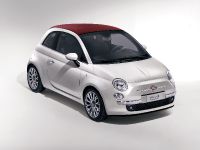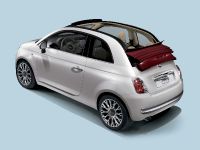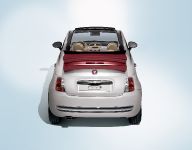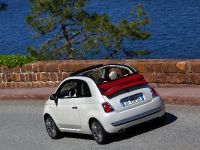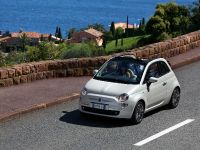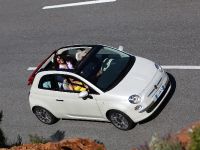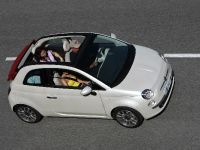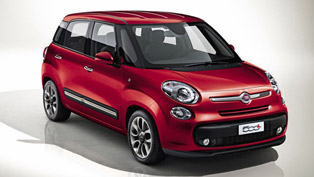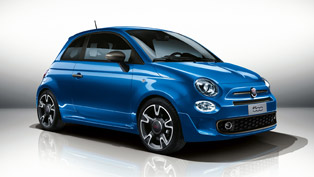Fiat 500C in the UK
Having made its international public debut at the 2009 Geneva Motor Show in March, the new Fiat 500 C, a convertible version of the iconic Fiat 500, goes on sale in the UK on Thursday 2 July – with the UK being the first market in the world to receive the vehicle.
The stylish new Fiat 500 C pays homage to the original 1957 fabric roof Fiat 500, but today's thoroughly modern interpretation offers customers innovative solutions in terms of mechanical design, engines and comfort.
The Fiat 500 C's introduction is thus absolutely in line with the authentic Fiat tradition of giving customers access to segment firsts in terms of content and technology, and comes just 18 months after the UK launch of the Fiat 500.
Fiat's Centro Stile created the 500 C by interacting with the many international communities of Cinquecento enthusiasts – notably the 500 Wants You website – thus reinforcing the position of the model as a car for the people, by the people.
Starting from the basis of the highly successful hatchback, the introduction of a soft top version does not change the winning characteristics of the model, such as its four comfortable seats and its comprehensive safety equipment, but it does add new functions that heighten enjoyment, including easy access to the boot even when the soft top is fully open, thanks to a clever system of parallelogram hinges.
Another strong point of this original convertible version is its exceptional climate and acoustic comfort. Thorough aerodynamic research means that turbulence experienced on the move with the roof open has been reduced to a minimum, allowing full enjoyment of fresh air and the company of fellow passengers.
The decision to re-interpret the original design in a modern idiom, with an electric sliding roof that retains the shape of this classic vehicle, makes the Fiat 500 C less of a seasonal product and one that can be enjoyed the whole year round. In short, all these features make this new vehicle one of the most successful convertibles in the modern city car segment.
The Fiat 500 C soft top stands out for its elegant electrically controlled movements and its impressively finished and carefully selected technical features, from the glass rear window to the third brake light built into the soft top itself. Available in three colours (ivory, red and black), the clever soft top is matched with various paint finishes, including three new creations: a pearlescent Ragamuffin Red, a Tech House Grey typical of high performance supercars, and Goth-Metal Blue.
The new Fiat 500 C has an exclusive feel to its interior, which is embellished with top quality desirable fabrics, including optional Frau leather upholstery, and a long list of market-dependent standard and optional features: from automatic climate control to its innovative Interscope HiFi System, from the Blue&Me Map portable navigation unit to a smart wind-stop, and a new collection of customisable options.
New Fiat 500 C retains the same dimensions as the hatchback (355 cm long, 165 cm wide and 149 cm high) and shares all three of its lively, economical, low emissions power units: the 75 bhp 1.3-litre MultiJet turbodiesel engine combined with a five-speed manual gearbox, together with the 69 bhp 1.2 litre and 100 bhp 1.4 litre petrol engines, both available with manual or Dualogic semi-automatic robotised gearboxes. Each Euro5-compliant engine offers different qualities, but all three are defined by a lively yet sophisticated feel.
The commercial launch of Fiat's latest convertible ensures that the Fiat 500 continues to be much discussed, and confirms its status as an Italian style icon, able to win over the public and critics worldwide. Clear evidence of its success are the 30 awards it has won worldwide, the 11 million internet users who have visited its website (viewing a total of 200 million pages) and more than 360,000 customer orders for the vehicle received in the 59 markets where it is now on sale.
This is all the more impressive when it's appreciated that more than half this vehicle's sales have been recorded outside Italy, (50 per cent elsewhere in Europe and 8 per cent in the rest of the world). In each country where it has been launched, the Fiat 500 has generated enormous interest: in Japan, for example, there have been more than 5,000 orders. It should also be recognised that 80 per cent of Fiat 500 customers select the most expensive features and 90 per cent ask for the Blue&Me system.
In short, as an expression of Italy's pre-eminent automotive design, the Fiat 500 is not merely a super-compact city car, but a real platform upon which Fiat Group Automobiles is building a whole family of cars with advanced technology and great attention to detail. The new Fiat 500 C represents another step forward in this direction.
Alluring shape and innovative design
"The Fiat 500 C is not merely the open version of the 500," explains Roberto Giolito, Fiat & Abarth Style Director. "In fact, thanks to the wide range of available versions, this new model is really a whole new car in its own right, with a strong personality inherited from the original 1957 model and an undoubted
sentimental value brought to it by so many fans over the years. If, on the one hand, the Fiat 500 C respects the original version, on the other it enriches it with new features which, thanks to stylistic choices, afford each one of us maximum freedom of use."
The Fiat 500 C uses a deeper windscreen than the Fiat 500. This is needed to resize the upper cross member; and affords a better view for the rear passengers, increases torsional rigidity and facilitates clean lines. These are also enhanced by the continuity of the windscreen, which extends to the fabric roof without exposing any part of the bodywork (an elegant and technologically sophisticated solution in keeping with the spirit of the 500 C).
If the soft top is down and the boot release is activated, an electronic system automatically lifts the hood a few centimetres to allow the boot to be fully opened. This functional and neat solution contributes to the fact that the Fiat 500 C is best in class for ease and versatility of loading and unloading. The luggage compartment itself, (with a capacity of 182 litres – just three litres less than the saloon version), together with a traditional upwards-opening boot and wide access, is spacious and easy to load.
The soft top is available in three colours (ivory, red and black) to match the numerous body colours (six pastel, three metallic and two pearlescent). Some of these are inspired by the vintage colours of its forerunner, while others are modern and boast a deliberately contemporary look. Among these, three were created specifically for the Fiat 500 C: pearlescent Ragamuffin Red, Tech House Grey (typical of high performance supercars) and elegant Goth-Metal Blue.
The interior of the Fiat 500 C boasts top quality materials. In particular, the new sporty seats are upholstered in a high quality durable fabric. The backrest and cushions of the rear seats keep passengers well located. As an option, the interior of the Fiat 500 C can be upholstered in black, beige or red Frau leather.
An innovative soft top for a unique style
The Fiat 500 C soft top is characterised by sophisticated electrically controlled movements and innovative technical solutions. In particular, a colour-coded moulding of the same colour as the soft top acts as a spoiler and houses a third brake light, creating similar aerodynamics to the saloon version – a class-leading Cx of 0.33.
In addition, when the soft top is down, the spoiler is arranged so that the third brake light is always visible. The double-layered roof fabric ensures the best possible insulation from the elements, and along with the fabric covered pillars, completes an attractive finish from the inside.
The electrically operated soft top can be controlled either by buttons next to the interior roof light, or from the car's remote control unit. In addition, the soft top can be operated at any speed under 37 mph (60 km/h).
The soft top is designed to be easy to use: to open it, just press the button for at least half a second to trigger the movement that then continues automatically up to the spoiler position (a midway point can of course be chosen by pressing the button again). Press the button again for at least half-a-second to fully open the roof. When using the remote control, the roof can be opened only as far as the spoiler. For safety reasons, the roof stops at around 25 cm from complete closure; (just press and hold the button to complete the movement).
When the boot is open, the soft top can only be closed (the opening function is de-activated). However, if the roof is fully open and the boot needs to be opened, the soft top automatically moves to a midway point to avoid obstructing loading operations.
Finally, an optional wind-stop can easily be positioned behind the rear headrests (attached to the parcel shelf). This wind tunnel-tested accessory has been designed specifically for the Fiat 500 C. It offers a notable reduction in turbulence for all passengers, at all speeds, and there is no need to remove the wind-stop to open or close the soft top (another unique feature for this vehicle segment).
Environmentally friendly engines
The Fiat 500 C offers a comprehensive range of proven, widely acclaimed engines: two are petrol (a 1.2 litre, 69 bhp 8v and a 1.4 litre, 100 bhp 16v). The third is Fiat's award-winning 1.3 litre, 75 bhp 16v MultiJet turbodiesel with DPF. Each one offers different qualities, but all are combined with five or six speed manual gearboxes. A Dualogic semi-automatic sequential robotised gearbox is also available for the petrol engines, complete with steering wheel paddle shift on the 1.4 version.
All engines boast sophisticated technology, and are characterised by their lively and flexible feel. Among their common qualities are proven reliability and notable respect for the environment. They all conform to tough Euro5 emissions standards, and the 1.3 litre MultiJet diesel is fitted with a diesel particulate filter as standard.
The Fiat 500's power units are produced by Fiat Powertrain Technologies (FPT), the division of the Fiat Group that is wholly responsible for the innovation, research, design and production of engines and gearboxes for all types of vehicle: from cars to trucks, boats and agricultural equipment. With around 20,000 employees, 16 factories and 11 research centres across nine countries, this division is one of the most important global players in powertrain manufacturing. At FPT, around 3,000 highly specialised technicians are dedicated to developing and engineering innovative technologies. More than 40 patents filed every year is proof of the quality and seriousness of this commitment, making FPT a centre of excellence for technology and continuous innovation.
Specifically, Fiat's proven and reliable 1,242 cm3 (1.2) Fire engine develops 69 bhp at 5,500 rpm, and torque of 102 Nm at 3,000 rpm, giving the Fiat 500 C a maximum speed of 99 mph. This 8v engine and manual gearbox in the Fiat 500 C offers outstandingly low fuel consumption of 55.4 mpg in the combined cycle and CO2 emissions of 119 g/km. 0-62 mph acceleration is achieved in 12.9 seconds, a figure that is all the more impressive given the car's low fuel consumption. Intelligent engine tuning is the key, as the power unit supplies high torque at low engine speeds (maximising driving pleasure and engine flexibility) combined with gear ratios carefully chosen to reduce consumption.
Fiat's 1.4 litre 16v engine delivers 100 bhp at 6,000 rpm and a maximum torque of 131 Nm at 4,250 rpm. Developed with strong performance and low consumption in mind, this engine puts the Fiat 500 C at the top of its class, with a top speed of 113mph and 0-62 mph acceleration in just 10.5 seconds. Fuel economy is impressive too: in the combined cycle, this version achieves 46.3 mpg (with a manual gearbox). With 100 bhp available, this compact car is capable of lively performance and quick responses in city traffic.
Fiat's new convertible is also available with a 1.3 litre, 16v MultiJet diesel – the smallest and most advanced second-generation common rail direct injection diesel engine. Equipped with a fixed geometry turbocharger and intercooler, this engine develops 75 bhp at 4,000 rpm and 145 Nm of torque at 1,500 rpm. It gives the Fiat 500 C strong performance: a top speed of 103 mph and acceleration from 0-62 mph in 12.5 seconds. Fuel consumption and emissions levels are also among the best in the segment: 67.3 mpg in the combined cycle and 110 g/km of CO2. This compact and technologically sophisticated power unit is also environmentally friendly and comes with a DPF as standard.
Class-leading safety
Structurally derived from the Fiat 500 hatchback (the first car under four metres to receive a five-star Euro NCAP crash safety rating), the Fiat 500 C retains all the safety components and features (active and passive) that justifiably place it among the market's best-in-class.
For example, with seven airbags offered as standard equipment, (two front, two window, two side and one knee bag) the Fiat 500 C is unrivalled in its segment in terms of passive safety. Furthermore, the new car's stable and efficient braking system combined with its responsive acceleration and reliable handling allows it to emerge unscathed from emergency situations.
The Fiat 500 C uses sophisticated technical solutions to ensure that the driver is in control of the car (active safety): such as ABS anti-lock braking with electronic brake distribution (EBD); an advanced electronic stability program (ESP); anti-slip regulation (ASR), a Hill Holder system – which helps the driver with hill starts – and hydraulic brake assistance (HBA) to help with emergency stops.
Moreover, to ensure the safety of the driver and passengers, the Fiat 500 C has a body designed according to the latest crash resistance criteria. This is the first super-compact car equipped with a front-end structure specifically designed to improve inter-vehicle compatibility in head-on collisions, with a rigid cabin to protect the occupants and high-absorption zones on the outside.
All four seat belts are three-point type – while both front belts have dual pretensioners and load limiters. The front and rear seats are equipped with an anti-submarining system that stops the wearer from sliding underneath the seatbelt during an impact. Isofix attachments for child car seats are fitted as standard across the range.
The Fiat 500 C also boasts modern and sophisticated components for preventive safety, especially when visibility is reduced; for example, at night or when in a tunnel. Thus, the Fiat 500 C is the first in its segment to offer, as an option, Xenon headlights with dipping and full-beam functions for better visibility and excellent light output in all weather conditions. The filaments of conventional gas-discharge bulbs have been replaced in Xenon units by two electrodes – just a few millimetres apart – that generate an electro-voltaic discharge in an atmosphere of low-pressure Xenon. Made by Magneti Marelli Automotive Lighting, these bulbs give three times the light intensity and duration of standard halogen bulbs.
The Fiat 500 C has all the dynamic and comfort features that allow users to embark comfortably and safely on any journey. The suspension system plays a fundamental role in this: front suspension is provided by independent MacPherson struts, while the rear suspension is semi-independent with a torsion beam axle. The semi-independent torsion-axle rear suspension system also features an anti-roll bar derived from the Abarth 500 to improve handling and comfort.
Standard and optional features
Customers have every opportunity to create a Fiat 500 C that best suits their individual preferences, thanks to an extensive range distinguished by 11 paint finishes, two equipment versions (Lounge and Pop) and three interior trims with different fabrics or leather, as well as over 100 accessory combinations created specially for the 500.
The UK range starts with the Pop version, which has a comprehensive standard equipment specification. In terms of safety, for example, there are seven airbags (two at the front, two window bags, two at the side and one to protect the knees), ABS anti-lock brakes with EBD and headlights with DRL (daytime running lights) function. The new 500 C Pop is available with all three engine configurations, and the 1.4-litre, 100 HP 16v engine also includes as standard the sophisticated ESP system and a sporty instrument panel.
For maximum comfort, the Fiat 500 C Pop offers the most advanced features on the market today: Dualdrive electric power steering, manual climate control, radio/CD/MP3 player, height-adjustable steering wheel, height-adjustable front seat, central locking and electric windows, ignition key with customisable remote control, and an ‘active' boot handle.
The Lounge version stands out for its Chrome kit, which includes chrome trim on the side windows, exhaust tail pipe, the interior door handle inserts, gear lever and the front and rear bumpers. Standard equipment includes automatic climate control, ESP, fog lights and parking sensors. The 185/55 R15 alloy wheels and electric wing mirrors painted to match the body also come as standard.
Xenon headlights with integrated headlamp washers, Frau leather interior, leather gear knob, Hi-Fi Interscope sound system and special 16-inch spoked alloy wheels are options on both Pop and Lounge versions.
Customers can also choose an important item of equipment developed in partnership with Magneti Marelli: the multifunctional portable navigation system Blue&Me MAP, while every Fiat 500 C is eco:Drive enabled.
Always looking to make the most sophisticated technology available to all, the Fiat 500 C has an innovative Interscope Hi-Fi system, which was designed and created specifically for the Fiat 500 and comes with a radio/CD/MP3 player. The Interscope Hi-Fi system is unique in the way it simultaneously uses three different signal processing methods to produce evocative in-car sound.
Lastly, to make each convertible unique, a new collection of Fiat 500 customisations is available. Noticeable for its attention to graphic detail, the new range is fresh in terms of original designs and the choice of a chrome finish. There is new sticker creativity, and fresh ideas for the car interior too: there are recreational items, such as the blackboard-style panel on the dashboard, but also everyday items, such as a make-up holder. In addition, the key fob lights up and can be further embellished with a key cover made from crystallised Swarovski elements.
Fiat 500 C technical specifications
| Dimensions | |||
| Length:3,546 mm - Width: 1,627 mm - Height: 1,488 mm - Wheelbase: 2,300 mm | |||
| Engine | |||
| 1.2 8v FIRE | 1.4 16v FIRE | 1.3 16v MultiJet | |
| Emission standards | Euro 5 | Euro 5 | Euro 5 |
| No. of cylinders and arrangement | 4, in line, transverse | ||
| Bore x stroke (mm) | 70.8 x 78.86 | 72 x 84 | 69.6 x 82 |
| Displacement (cm3) | 1242 | 1368 | 1248 |
| No. of valves per cylinder | 2 | 4 | 4 |
| Compression ratio | 11.1 :1 | 10.8 : 1 | 17.6 : 1 |
| Max. power output: bhp (kW) at rpm | 69 (51) 5500 | 100 (73,5) 6000 | 75 (55) 4000 |
| Peak torque: kgm (Nm) at rpm | 10.4 (102) 3000 | 13.4 (131) 4250 | 14.8 (145) 1500 |
| Tappet control | Mechanical tappets (1 x OHC) | Finger rocker arm with hydraulic tappets (2 x OHC) | |
| Timing (control) | Toothed belt | Toothed belt | Chains |
| Fuel supply | Sequential and timed electronic MPI | Common Rail MultiJet direct injection, electronically controlled with turbo intercooler | |
| Ignition | Static advance, electronic, integrated with the injection | Compression | |
| Emissions control | Three-way catalyst in engine bay, 2 Lambda probes, EOBD | Oxidising catalyst in engine bay, Lambda probe, electrical EGR valve, EOBD, particulate filter (DPF) | |
| Transmission | |||
| Drive | Front | Front | Front |
| Clutch | Mechanical, self-adjusting | ||
| Brakes - D (disc) – T (drum) | |||
| Front (mm) | D240 ventilated | D257 x 22 ventilated | D240 ventilated |
| Rear (mm) | T180 | D240x11 (full) | T180 |
| 1.2 8v FIRE | 1.4 16v FIRE | 1.3 16v MultiJet | |
| Suspension | |||
| Front | Independent, MacPherson strut suspension with transverse lower wishbones secured to an auxiliary cross member; anti-roll bar connected to the shock-absorber | ||
| Rear | Semi-independent suspension with torsion beam axle and anti-roll bar | ||
| Performance and fuel consumption | |||
| Top speed (mph) | 99 | 113 | 103 |
| Acceleration 0-62 mph (secs) | 12.9 | 10.5 | 12.5 |
| Consumption (mpg)urban/extra-urban/combined cycles | |||
| Manual gearbox Dualogic gearbox | 44.1 65.7 55.4 45.6 65.7 56.5 | 36.6 55.4 46.3 39.8 56.5 48.7 | 53.2 78.5 67.3 - - - |
| CO2 (g/km) | 119 | 140 | 110 |
